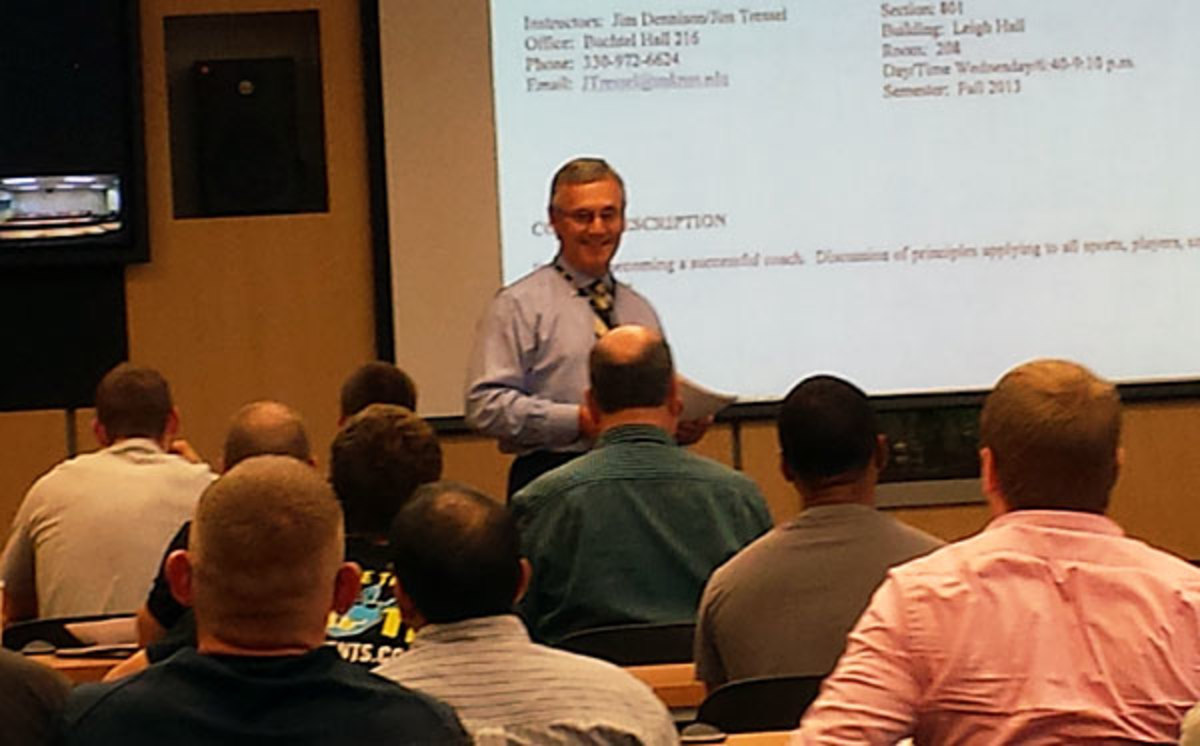Coaching in the classroom: An inside look at Jim Tressel's new course at Akron

Jim Tressel teaches a class called "Principles of Coaching" on Wednesday nights at Akron. (Martin Rickman/SI)

“If we could have your attention please …”
Jim Tressel stood in front of a room filled with close to 100 people, ranging from college girls to retiree-aged men. It was impossible not to notice his sweater vest was absent. The only ring Tressel wore was his wedding band. Things got quiet, fast.
This was the first week of “Principles of Coaching,” the class Tressel and Jim Dennison are teaching in Leigh Hall at the University of Akron. Dennison is the winningest football coach in school history, going 80-62-2 over his 13-year tenure with the Zips.
Tressel is an imposing presence on Akron's campus. His new title, Vice President for Student Success, means he has his hands in every department of the university. He’s constantly speaking, meeting with people and offering suggestions. He’s a coach in every sense of the word, even if he doesn’t roam the sidelines anymore.
“I have been fortunate enough to get my education all around the world,” Akron Department of Sport Science & Wellness Education chair Dr. Victor Pinheiro said, “and I’ve had the best of teachers. I’ve worked with Nobel Laureates and all that good stuff. And [Tressel] stands right up there with them. The knowledge base he brings to this domain is just amazing.”
The students at Akron are like students everywhere, adolescents slowly becoming men and women, still trying to understand identity before they can start to figure out what their own identity is. In regard to college sports, the words student and student-athlete get tossed around a lot, especially during scandals like the one that enveloped Tressel’s final days at Ohio State.
But being a student-athlete means something. So does being a coach. And to hear Tressel and Dennison tell it, coaches are sometimes their kids’ only consistent point of contact.
*****
“We happen to believe one of the greatest needs in this country -- we have 60 to 65 million young people playing sports -- we have so many opportunities for coaching. We can build a foundation at a young age and have an impact. The impact we can have, and need to have, as coaches is tremendous.”
In 1975, after Tressel finished his college career as a quarterback at Baldwin-Wallace University, in Berea, Ohio, he was invited by then-Akron coach Dennison to come on as a graduate assistant. Tressel sat through a class very similar to the one he now teaches on Wednesdays this fall. Back then, he wasn’t Jim Tressel, embattled former Ohio State coach. He wasn’t even Jim Tressel, Youngstown State head coach. He was Jim Tressel, 23-year-old young adult. His journey had barely begun.
In the introductory “Principles of Teaching” lecture, Dennison likewise went through his career progression. He lost his father at a young age, and his coaches were there for him. They set him on a path to become the person he would be down the road.
“The two most important days of your life are the day you were born and the day you found out why,” Dennison said. “I found out when I was a junior in high school. I wanted to be a coach.”
Life is one big series of decisions. For those who have lived a life as full as Dennison has, those decisions carry a bit more weight.
“This is a great profession because of the great people,” Dennison said. “It’s never been about me; it’s always been about others.”
*****
“Coaching is the purest form of teaching there is. We are responsible for players 24 hours a day. […] When the misfortune happens, we’re a part of that too.”
It’s probably no mere coincidence that the repeated refrain in the first week of “Principles of Coaching” was that the coach is ultimately responsible for the player. That extends to on-field technique, player safety and the way an athlete handles himself in society.
At some point during the class, that lesson brought to mind the Buckeyes’ now-infamous tattoo-parlor scandal. And Penn State. And concussions. And Aaron Hernandez. None of it felt right, but given the teacher and subject material, the connection was inescapable.
People associate coaches with their records. That is, until they don’t.
“They’re both positive men, and they’ve both been through a lot,” student John Hannon said of Tressel and Dennison. Hannon was in campus ministry at Akron while Dennison was coaching, and he read devotions to the football team as an honorary chaplain. Now a part-time professor at John Carroll University, Hannon decided to take “Principles of Coaching” to learn the parallels between coaching and life.
“They’ve learned from their mistakes and learned from their failure,” said Hannon, “and the biggest thing they’ve already said is that coaching is basically bringing the best out of those you have responsibility for and helping them be the best they can be.”
Jim Tressel led Ohio State to a BCS title, but resigned following a tattoo scandal. (Gregory Shamus/Getty Images)

Tressel outlined a list of characteristics that truly make a coach, from patience to the importance of never losing sight of the big picture. He also referenced a quote from Albert Einstein, which he repeated until the class (and the individuals participating at satellite campuses via a live feed) had written it down.
“Concern for man and his fate must be the chief interests of all technical endeavors. Never forget this in the midst of your diagrams and equations.”
Coaches spend the vast majority of their time figuring out how to win games, which is the single most important factor when it comes to keeping their jobs. They must overcome scrutiny and deal with off-the-field issues while simultaneously managing expectations, stress and their own personal relationships. It’s when that combination of things becomes bigger than the players they’re responsible for that the cracks begin to show.
“I either taught them that or I allowed it to be that way,” Tressel said, “and I didn’t see the signs. It’s the coaches’ fault when you see the wrong behaviors.”
Standing in front of a classroom, Tressel was dynamic. There were even whispers that he might be the next president of the university. He cracked jokes; at one point during the class, a student near the front admitted to being a University of Michigan and Cleveland sports fan. Tressel responded: “So you’re used to being miserable.”
If he’s not at peace with the events that led to his resignation at Ohio State, which included a pattern of violations that SI extensively investigated and reported, he doesn’t show it publicly. He has moved on, away from the Horseshoe, away from the scarlet and gray, away from the school he once led to a BCS championship.
But Tressel is a career coach. Coaches care about their former players, and he is no exception. At one point, he perked up when a student admitted to being an Oakland Raiders fan.
“Terrelle [Pryor] is starting tomorrow!” Tressel said. (Pryor has since been named the Raiders starting quarterback for Week 1.)
“Maybe,” the student said.
“What do you mean maybe?” said Tressel. “I talked to him yesterday. You know something I don’t?”
*****
“The kids haven’t changed as much as the parents have. They want to know what you expect. There’s the opportunity.”
As long as there are sports, there will always be coaches. And coaches have to learn from someone, too.
Tressel learned from his father, Dr. Lee J. Tressel. He also learned from Dennison, as did Mark Dantonio, who later coached with Tressel at Youngstown State and then with Nick Saban at Michigan State. Saban learned from Don James, who also mentored Missouri’s Gary Pinkel. It seems like half the coaches in the MAC got their start under Tressel or someone who coached with Tressel. (As Tressel was leaving Ohio State to become Youngstown State’s head coach in 1986, a young high school coach named Urban Meyer was hired as a graduate assistant with the Buckeyes.)
“Help other people get what they want,” Dennison said during his portion of the class, “and you can get anywhere.”
Dennison also quoted John Wooden, making the class write a phrase down word for word.
“Success is the peace of mind which is the direct result of the self-satisfaction in knowing you did your best to become the best you’re capable of becoming.”
Coaching trees stand as evidence of two things: One, there’s no way of knowing who will become the next great head coach; and two, there’s no way of knowing where that coach will come from. She might be the woman in the corner who is coaching Little League. Or he might be the first-timer driving in from Pennsylvania who always wanted to coach but never knew how. He might be the star basketball player taking this class because his coach is a guest speaker.
“I may not want to be a coach per se,” Sport Administration and Coaching graduate student Ashley Mowen said, “but I feel like both of them, both Jims, their philosophies on coaching and leading will carry out through life.”
Not everyone in Tressel’s class will be a coach someday.In fact, most won’t. But there are particular lessons that Tressel and Dennison want their students to take away from their experience.
